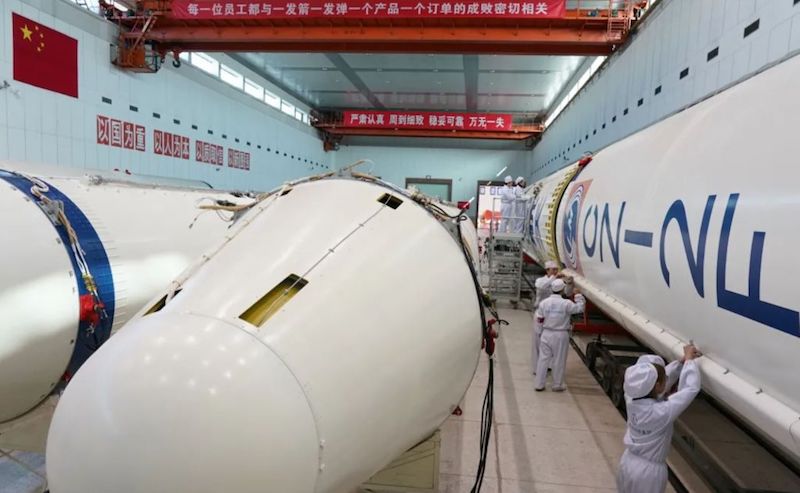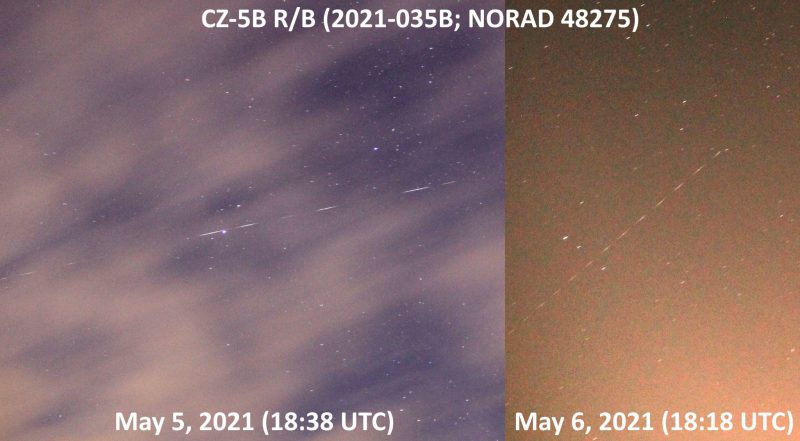
China is getting ready to launch three taikonauts – Chinese astronauts – into low Earth orbit. The mission, Shenzhou 12, is China’s first crewed mission to the Tiangong space station. There’s been no word of an official launch date for Shenzhou 12. However, it’s likely that a Long March 2F rocket will deliver the trio to rendezvous and dock with the Tianhe module sometime this month. It was initially rumored to be June 10, 2021, but now appears scheduled for June 17.
The China Manned Space Engineering Office (CMSEO) announced that the spacecraft and rocket for the launch arrived at the Jiuquan Satellite Launch Center (JSLC) in mid-April. On April 28, Space.com reported that the rocket and its spacecraft were currently undergoing final assembly and testing at the site. Then, on May 29 the Tianzhou-2 cargo spacecraft docked with the Tianhe space station module to deliver supplies and propellant in preparation for the Shenzhou 12 crew. China has traditionally released very little detail about upcoming missions. So it is with Shenzhou 12. But the deliveries to the JSLC and Tianhe module may mean that the crewed mission will be ready to fly soon.
It’s unclear how long the mission will last. The taikonauts may spend months in orbit, testing systems and preparing for the next modules and Tianzhou spacecraft. In total, China plans to send 11 missions in 2021 and 2022 to complete the space station complex. Of the 11 missions, three will launch modules, four will deliver cargo, and four will carry a crew.
Shenzhou 12 heads for Tiangong Space Station
The station is expected to house three taikonauts for three months at a time. It will, however, have a capacity of six crew members for mission changeovers. Tiangong is expected to be about 1/5 the mass of the International Space Station (ISS). The U.S. barred China from ISS. More specifically, NASA has prohibited any space project cooperation with China since 2011 due to “national security concerns,” according to Newsweek.
China is also yet to reveal the names of the Shenzhou crew members, but said in March that they’ve been in intense mission training. The agency may publicly announce their names less than 24 hours before the launch, as with previous missions. So far, China has launched six crewed missions. The most recent, in 2016, was the two-person Shenzhou 11 mission to the Tiangong-2 module.
China … on a roll?
The Chinese government sat out the famous 1960s space race between the Soviet Union and the U.S., in which the U.S. ultimately landed the first humans on the moon in 1969. But, in recent years, China has been making up for lost time. It’s launched several robotic missions to the moon and Mars. Lunar expeditions include a landing on the moon’s far side and a historic lunar sample return mission. The Chinese probe Tianwen-1 landed on Mars on May 14, 2021.
The fiery fate of Long March 5B
However, China’s success is vulnerable to scrutiny by overseas leaders. NASA’s new administrator Bill Nelson released a rare statement criticizing China’s handling of the reentry of the Long March 5B rocket. The core stage of China’s 100-foot (30-meter) Long March 5B rocket – which launched the Tianhe module – plummeted into the Indian Ocean near the Maldives on May 8.
It was one of the largest ever pieces of space debris to make an uncontrolled reentry back into Earth’s atmosphere. Sightings and videos circulated on social media platforms as the rocket began its final orbits around Earth. According to the CMSEO, the core stage fell around longitude 72.47 degrees east and latitude 2.65 degrees north. Luckily, there were no casualties.

Spacenews.com reported that, according to Chinese space officials, a Long March 2F and Shenzhou spacecraft will be on standby at Jiuquan at all times in case an emergency rescue mission needs to launch to the space station.
Bottom line: China is getting ready to launch three taikonauts – Chinese astronauts – into low Earth orbit. The mission, Shenzhou 12, will be China’s first crewed mission to the Tiangong space station. There’s no word of an official launch date. It was initially rumored for June 10, 2021, and now appears to be slated for June 17.
Read more from EarthSky: The Fiery Fate Of China’s Long March 5B Rocket











